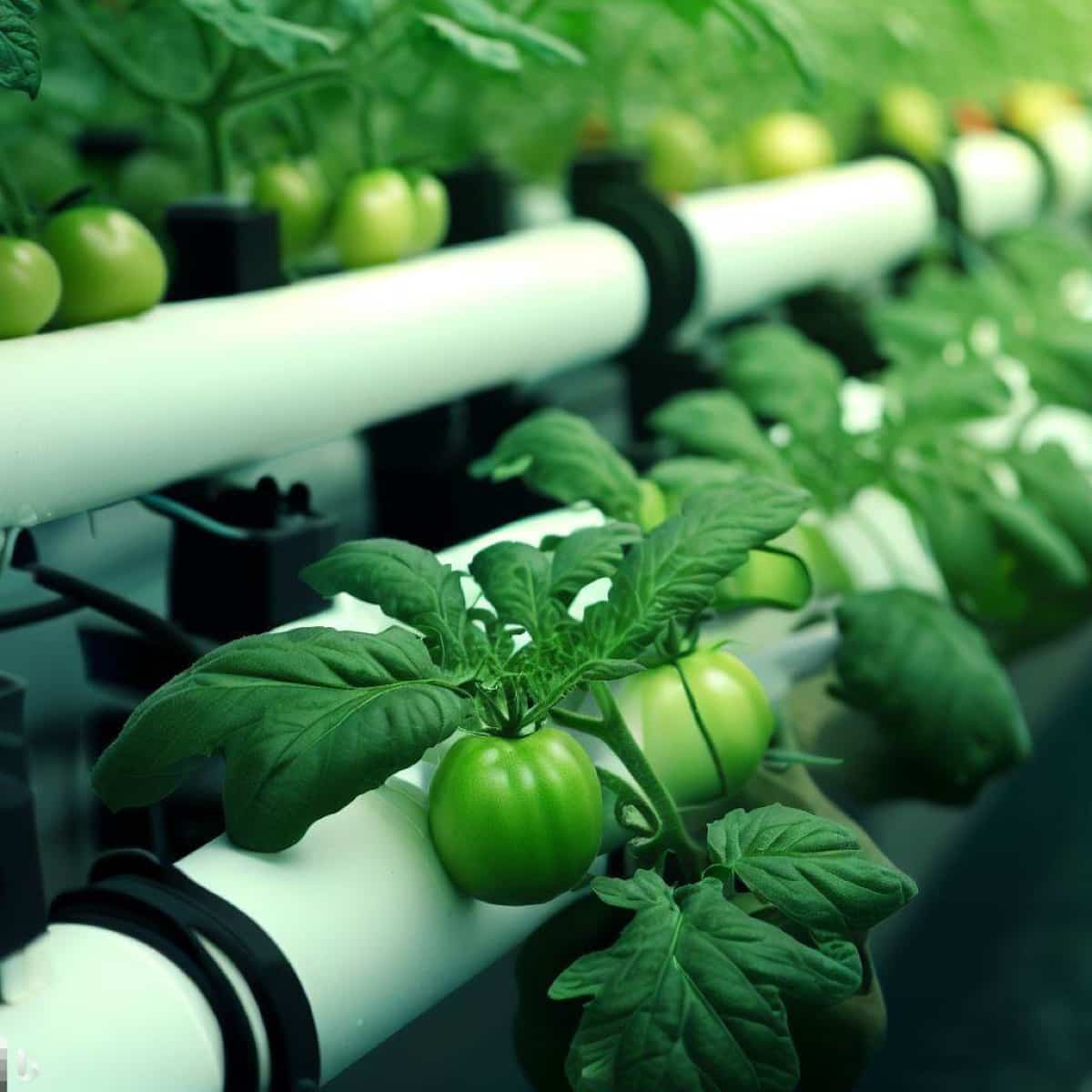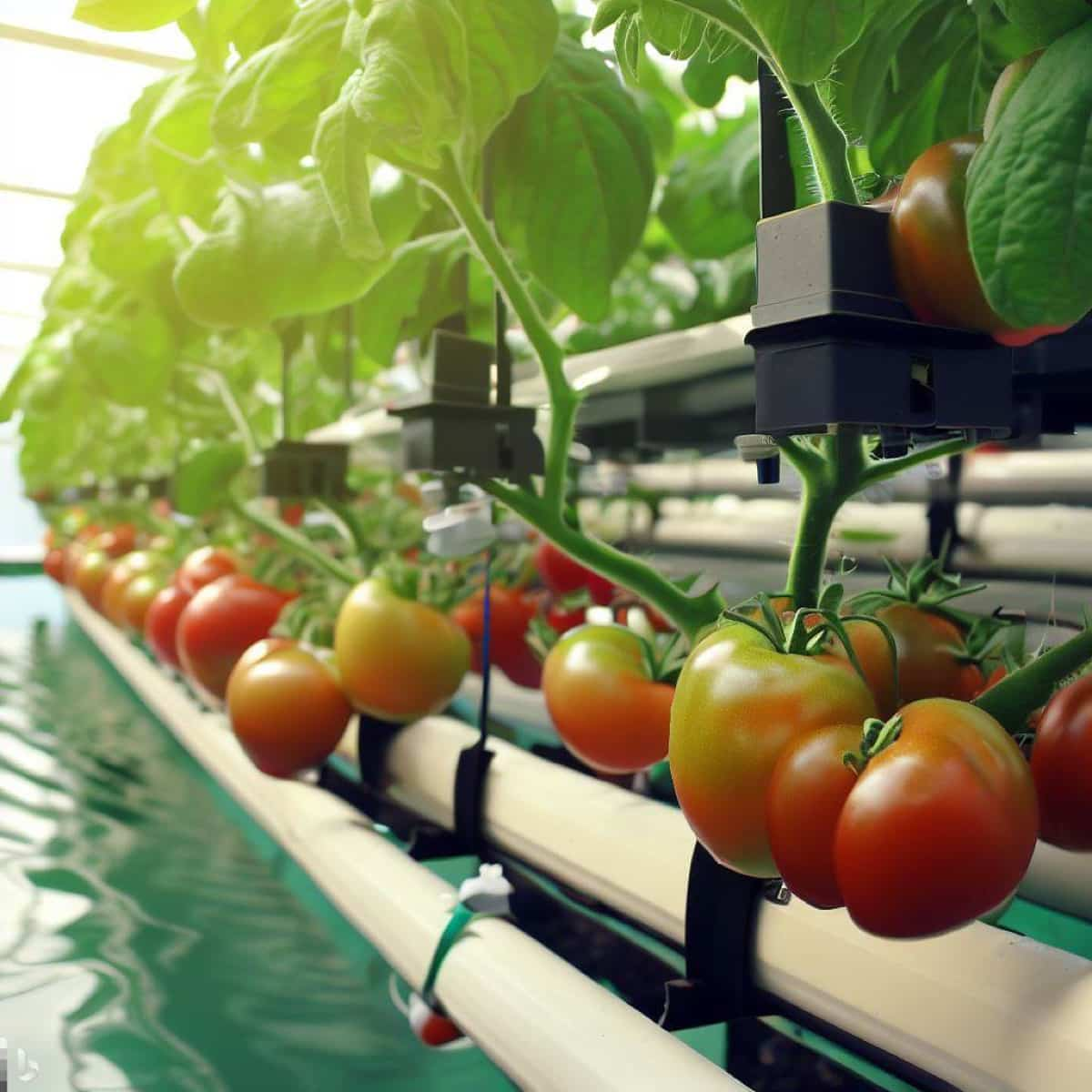Welcome to our comprehensive guide on Aquaponic Tomatoes: A Step-by-Step Growing Guide for Beginners. Aquaponics is a sustainable and innovative farming method that combines aquaculture and hydroponics, creating a harmonious ecosystem where fish waste provides nutrients for tomato plants. In this easy-to-read blog, we’ll walk you through the entire process, from setting up your aquaponics system to caring for your tomatoes. Discover the optimal water conditions, suitable fish species, and how to achieve maximum yield with minimal effort.

What is Aquaponic Tomato Cultivation?
Aquaponic tomato cultivation is a sustainable and innovative method integrating aquaculture and hydroponics to grow tomatoes. In this system, fish waste provides essential nutrients to the tomato plants, while the plants, in turn, purify the water for the fish. This symbiotic relationship creates a self-sustaining ecosystem, reducing water consumption and minimizing environmental impact. The aquaponic setup typically consists of a fish tank, where fish like Tilapia, catfish, or trout are raised, and a grow bed where tomato plants are cultivated.
A water pump circulates the water between the fish tank and the grow bed, facilitating nutrient transfer. Monitoring and check water quality is needed for successful tomato growth, with pH levels around 6.0-6.8 and a temperature range of 70-85°F being ideal. Aquaponic tomatoes benefit from constant access to nutrients and a controlled environment, leading to faster growth and year-round harvests. This method also requires minimal pesticide use, making it an eco-friendly option.
Best Practices for Growing Tomatoes in Aquaponic Systems
- Temperature and Water pH Tomatoes thrive between 65°F and 85°F, but growth stops beyond 95°F. To achieve the best results, maintain the aquaponics system’s temperature between 75°F and 85°F. Water pH should be kept between 5.5 and 6.5, a lower range than other plants.
- Matching Fish and Tomatoes Using fish like Tilapia, koi, crappie, goldfish, or angelfish is recommended for warmer water. Trout can be used, but it results in slower tomato growth.
- Nutrient Demands and Support Structure Tomato plants need 1 to 2 feet spacing, ample sunlight, and a support structure to grow vertically without interference.
- Nutrient Requirements Tomatoes require nitrogen for vegetative growth and potassium for transitioning from flowering to fruiting. They can tolerate some salt in water, enhancing their fruiting ability.
- Trimming and Harvesting Regular trimming, especially removing lower leaves, improves nutrition distribution and encourages bigger tomatoes. Tomatoes can yield 25 to 35 fruits per plant, with the first harvest usually within eight weeks.
- Best Growing Techniques Gravel beds (limestone-free) or Deep Water Culture (DWC) methods are popular for tomato aquaponics. DWC involves creating a canal with growing media-filled pots partially submerged in water.
- Choosing Healthy Seedlings Obtain tomato seedlings from reliable sources to ensure strong and healthy growth.
How to Optimize Tomato Production in Aquaponics
To maximize tomato production in aquaponics, ensure ideal conditions for growth. Maintain water temperature between 65°F to 80°F (18.5°C to 26.5°C) and pH levels at 6.0 to 6.5. Use media beds filled with limestone-free grow media like clay pebbles for best yields. Tomato varieties like Heirloom, Beefsteak, Cherry, and Plum grow well in aquaponics systems. Regularly trim plants and keep the water aerated to support nutrient uptake. Expect a yield of 9 to 18 lbs (4 to 8 kgs) per plant, with 60 to 90 days of harvesting.
Choosing the Right Tomato Varieties for Aquaponic Gardening
- Cherry Tomatoes: Ideal for small aquaponic systems due to lower nutrient demands. They produce small, sweet, and bite-sized fruits.
- Plum Tomatoes: These varieties are perfect for sauces and pastes. They have fewer seeds and denser flesh, making them suitable for processing.
- Heirloom Tomatoes: Known for their diverse shapes, colors, and flavors. They are popular for their unique taste and are great for adding variety to your harvest.
- Beefsteak Tomatoes: Preferred for their large size and juicy, meaty texture. Perfect for sandwiches and salads.
- Black Plum Tomatoes: Unique and dark-colored, these tomatoes offer a rich, sweet flavor profile.
- Grape Tomatoes: Small and oblong, with a sweet and tangy taste. Great for snacking and salads.
Maintaining Optimal Nutrient Levels for Tomato Plants in Aquaponics
- Nitrogen Balance: During the early stages, tomato plants need sufficient nitrogen for robust vegetative growth. As they mature, potassium becomes essential for flower and fruit formation.
- Fish Food: Feeding the fish high-quality food is vital, as their waste provides plant nutrients. Proper fish nutrition directly affects nutrient availability for tomatoes.
- Water Quality: Regularly monitor water parameters like pH and temperature. Tomatoes prefer slightly acidic pH levels between 6.0 and 6.5.
- Fish Waste Filtration: Efficient filtration systems, such as radial flow filters and mechanical filters, remove excess solids from fish waste, preventing nutrient imbalance.
- Testing and Adjusting: Regularly test water for nutrient levels and adjust using supplements like seaweed-based nutrients, to maintain the right balance.
In case you missed it: How to Setup a Backyard Aquaponics System: A Step-by-Step Guide

Controlling Pests and Diseases in Aquaponic Tomato Cultivation
Implement integrated pest management (IPM) techniques to reduce reliance on chemicals. Introduce beneficial insects like ladybugs to control aphids and whiteflies naturally. Regularly observation of plants for signs of pests and promptly address any issues. Keep the system clean and remove debris to deter pest habitats. For diseases, maintain proper water quality and avoid overwatering to prevent root rot. Quarantine new plants to avoid introducing pathogens.
Harvesting and Post-harvest Handling of Aquaponic Tomatoes
Tomatoes should be picked when fully ripe, as they do not continue to ripen after harvesting. Gentle handling is essential to avoid bruising and damage to the fruits. After harvest, tomatoes should be stored at room temperature 15-25°C away from direct sunlight to preserve their taste and texture. Refrigeration can negatively impact their flavor. Additionally, removing stems and leaves before storage can help prolong shelf life. Proper post-harvest handling ensures that aquaponic tomatoes reach consumers at their peak freshness.
Troubleshooting Common Issues in Aquaponic Tomato Production
- Nutrient Imbalance: Monitor water pH, nitrogen, and potassium levels to prevent nutrient deficiencies affecting tomato growth.
- Poor Water Quality: Regularly test water for contaminants and maintain proper aeration to avoid detrimental effects on plants.
- Pest Infestations: Implement natural pest control methods like introducing beneficial insects or using neem oil to manage pests without harming the ecosystem.
- Disease Outbreaks: Conduct regular inspections and promptly remove infected plants to prevent diseases from spreading in the aquaponic system.
- Algae Overgrowth: Control light exposure and reduce nutrient load to prevent excessive algae growth, which can deplete oxygen and harm fish.
- Fish Stress: Ensure water temperature and quality are suitable for the fish species, as stressed fish may lead to nutrient deficiencies for tomatoes.
- Clogged Grow Beds: Clean grow media regularly to prevent clogging and improve water flow for better plant nutrient distribution.
- Inadequate Pollination: Encourage pollination by providing a gentle breeze or manually pollinating flowers to boost the fruit set.
- Root Rot: Avoid overwatering and ensure proper drainage to prevent root rot in tomato plants.
Maximizing Yield and Quality of Aquaponic Tomatoes Through Proper Care
Maintain water temperature between 65°F to 80°F (18.5°C to 26.5°C) and pH levels at 6.0 to 6.5. Utilize media beds with limestone-free grow media like clay pebbles. Select tomato varieties suitable for aquaponics, such as Heirloom, Beefsteak, Cherry, or Plum. Regularly trim plants and keep the water well-aerated to support nutrient uptake. Monitor potassium and nitrogen levels for robust fruiting. Implement a controlled environment with consistent temperature and humidity.
Innovative Techniques for Enhancing Tomato Growth in Aquaponics
Trellising and pruning techniques in aquaponics improve air circulation and light exposure, increasing health and yield. CO2 enrichment stimulates photosynthesis, boosting productivity. Aquaponic biofilters convert fish waste into plant-available nutrients, optimizing tomato growth. These innovative techniques enhance overall health and yield.
In case you missed it: 10 Common Problems With Aquaponic Farming: How to Fix, Treatment, and Solutions

Conclusion
Aquaponic tomatoes offer a sustainable way for beginners to grow fresh, nutrient-rich produce. Following the step-by-step guide can create a harmonious ecosystem, ensuring successful tomato cultivation and delicious harvests year-round.
- Feed Your Flock for Less: Top 10 Tips to Save on Chicken Feed
- Ultimate Guide to Ossabaw Island Hog: Breeding, Raising, Diet, and Care
- Hatching Answers: The Top 10 Reasons Your Chickens Aren’t Laying Eggs
- Eggs and Economics: Breaking Down the Cost of Raising Backyard Chickens
- Defend Your Greens: Proven Methods to Keep Iguanas Out of Your Garden
- Ultimate Guide to Cinnamon Queen Chicken: A Comprehensive Guide for Beginners
- Ultimate Guide to California Tan Chicken: Breeding, Raising, Diet, Egg-Production and Care
- Ultimate Guide to Marsh Daisy Chicken: Breeding, Raising, Diet, and Care
- 10 Types of Chicken Farming Businesses You Can Start for Profits